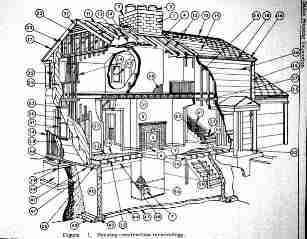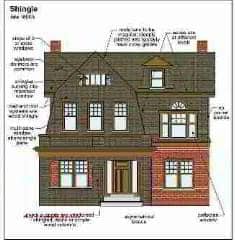 Scope of a Home Inspection
Scope of a Home Inspection
What building components and systems are examined in a professional Home Inspection?
- POST a QUESTION or COMMENT about the scope of a professional home inspection
Scope of a home inspection:
What major building comonents, structures, & mechanical systems must be included in a professional home inspection?
This article lists the "significant building components and systemns" included in a professional home inspection and referred to by professional standards.
InspectAPedia tolerates no conflicts of interest. We have no relationship with advertisers, products, or services discussed at this website.
- Daniel Friedman, Publisher/Editor/Author - See WHO ARE WE?
Major Components & Systems Included in a Professional Home Inspection
 The New York State home inspection licensing law as well as similar laws adopted in many U.S. states and Canadian province a home inspection Standard of Practice that includes details defining the scope of a home inspection: which items should be covered and which may be omitted.
The New York State home inspection licensing law as well as similar laws adopted in many U.S. states and Canadian province a home inspection Standard of Practice that includes details defining the scope of a home inspection: which items should be covered and which may be omitted.
Some of these laws and regulations also specify a code of ethics for home inspectors.
Watch out: a definition of the scope of an inspection will not include and could not include the additional detail necessary to define pass-fail criteria for the condition of the items that are inspected.
However a proper standard of practice or home inspection licensing law should require that when the professional inspector finds a substantive deficiency or unsafe condition, she or he must communicate that adequately to the client and for safety items, to others who may be affected such as a building owner or occupant.
Here is an example: the NEW YORK STATE HOME INSPECTION PROFESSIONAL LICENSING [PDF] June 2016, New York Department of State, Division of Licensing Services, Article 12-B, Real Property Law, Rules and Regulations Title 19 NYCRR Part 197 Home Inspectors, including Subpart 197-5 Standards of Practice for Home Inspectors, retrieved 2018/07/19, original source: https://www.dos.ny.gov/licensing/lawbooks/HomeInspectionProfessional.pdf
Before and also after state licensing, standards of practice and codes of ethics for home inspection and home inspectors were promulgated first by The American Society of Home Inspectors - ASHI is the national testing, certification, and ethical standard professional association for home inspectors. The ASHI Standards of Practice define the minimum acceptable scope of a professional home inspection.
Other home inspection professional associations or industry-promotion and protection associations have published similar standards and codes of ethics on their own. In many cases those were used as models for subsequent state or provincial home inspection licensing and certification.
The intent of the inspection is that all substantive systems and components that make up the building shall be examined by the home inspector, and that significant defects and dangerous conditions shall be reported to the client orally and in writing. Some items which are numerous but of minor individual cost such as electrical outlets may be sampled using a strategy based on observation and experience.
Other numerous items, such as plumbing fixtures, must all be examined for proper operation and evidence of damage to the building. The ASHI Standard of Practice protects consumers from engaging an inspector who is unprofessional - someone who might be great at roofing but who makes no inspection of plumbing components, for example.
HOME INSPECTION STANDARDS (ASHI) and similar standards of home inspection practice published by other home inspector associations or certifying agencies such as the New York Real Property law Subpart 197-5 Standards of Practice for Home Inspectors typically list these major systems:
- Site conditions
- Structural Systems such as foundations, wall and roof framing
- Exterior building surfaces and components other than temporary or portable items
- Roof System
- Plumbing System
- Electrical System
- Heating System
- Air Conditioning System
- Interior building surfaces and components other than temporary or portable items
- Insulation and Ventilation
- Fireplaces and Solid Fuel Burning Appliances as well as chimneys and vents for these devices.
- Attics [why there are not explicit sections on "basements" and "crawl spaces" in the New York Law is a curiosity - Ed]
- Limitations & Exclusions
The intention is that all of the substantive physical components and systems that make up the structure, and certain other conditions (such as site drainage) which affect the structure, shall be examined.
Watch out: The list above is intended to give the broad scope of a professional home inspection and does not include detailed components or topics. But we do provide that detail. For extensive inspection, diagnostic, and repair advice on virtually all building components and systems, readers should note the list of building topics across the top of each page at InspectAPedia.com and also be sure to review the much more detailed building inspection topic & defect lists described at
Home buyers and home inspectors who need to know the detailed standards to which a home inspection should be conducted should examine the ASHI Standard of Practice as well as their local or State versions of similar home inspection laws and guidelines if such are provided in their state.
Normally excluded from a pre purchase home inspection are environmental concerns such as mold, radon, lead, and also excluded are calculations or estimations of system capacities or adequacies, such as cooling or heating capacity.
However home inspectors are not prohibited from offering additional inspection and testing services, including but not limited to such items as mold testing, radon testing, water and septic testing, termite or wood destroying insect infestation inspections, energy audits, heating and air conditioning system inspections, other environmental tests, provided the home inspector is qualified and meets any state or local licensing requirements for those activities.
Home inspectors are (or should be) prohibited from offering to perform repair work on properties that they inspect as well as a general prohibition against any conflicts of interest among their client and other parties involved in owning, selling, or providing services to the property they inspect.
Appliances such as dishwashers, ranges, ovens, and clothes washers as well as portable or window air conditioners or air cleaners are not required to be inspected by most inspection standards, but these may be included in the practice of some home inspectors.
...
Continue reading at HOME INSPECTION STANDARDS & ETHICAL CODES or select a topic from the closely-related articles below, or see the complete ARTICLE INDEX.
Or see these
Home Inspection Articles for Consumers & Home Inspectors
- ADVANCED INSPECTION METHODS
- BUILDING INSPECTION SURPRISE PROVES NEED for SCOPE
- CONSULTANTS & EXPERTS DIRECTORIES
- FEAR-O-METER: Dan's 3 D's SET REPAIR PRIORITIES a promotion theory to convert risk of hidden defects & hazards into action thresholds
- HOME & BUILDING INSPECTION - home
- HOME INSPECTION ADVANCED TOPICS
- HOME INSPECTION BUSINESSES & FRANCHISES
- HOME INSPECTION, GET THE MOST FROM
- HOME INSPECTION PUBLICATIONS
- HOME INSPECTION REPORT WRITING
- HOME INSPECTION STANDARDS & ETHICAL CODES
- HOME INSPECTION COMPONENTS, MASTER LIST
- HOME INSPECTION DEFINITIONS & TERMS
- HOME INSPECTION ETHICAL CODES
- HOME INSPECTION SAFETY
- HOME INSPECTOR CERTIFICATION
- HOME INSPECTION SCOPE of COVERAGE
- INACCESSIBLE / SHUT_DOWN AREAS / EQUIPMENT
- HOME INSPECTOR CERTIFICATION
- HOME INSPECTOR EDUCATION
- HOUSE DOCTOR, HOW TO BE A
- HOW MUCH SHOULD YOU PAY
- VISUAL PERCEPTION ERRORS
Suggested citation for this web page
HOME INSPECTION SCOPE of COVERAGE at InspectApedia.com - online encyclopedia of building & environmental inspection, testing, diagnosis, repair, & problem prevention advice.
Or see this
INDEX to RELATED ARTICLES: ARTICLE INDEX to BUILDING & HOME INSPECTION
Or use the SEARCH BOX found below to Ask a Question or Search InspectApedia
Ask a Question or Search InspectApedia
Try the search box just below, or if you prefer, post a question or comment in the Comments box below and we will respond promptly.
Search the InspectApedia website
Note: appearance of your Comment below may be delayed: if your comment contains an image, photograph, web link, or text that looks to the software as if it might be a web link, your posting will appear after it has been approved by a moderator. Apologies for the delay.
Only one image can be added per comment but you can post as many comments, and therefore images, as you like.
You will not receive a notification when a response to your question has been posted.
Please bookmark this page to make it easy for you to check back for our response.
Our Comment Box is provided by Countable Web Productions countable.ca
Citations & References
In addition to any citations in the article above, a full list is available on request.
- John Cranor [Website: /www.house-whisperer.com ] is an ASHI member and a home inspector (The House Whisperer) is located in Glen Allen, VA 23060. He is also a contributor to InspectApedia.com in several technical areas such as plumbing and appliances (dryer vents). Contact Mr. Cranor at 804-873-8534 or by Email: johncranor@verizon.net
- Mark Cramer Inspection Services Mark Cramer, Tampa Florida, Mr. Cramer is a past president of ASHI, the American Society of Home Inspectors and is a Florida home inspector and home inspection educator. Contact Mark Cramer at: 727-595-4211 mark@BestTampaInspector.com 11/06
- Roger Hankey is principal of Hankey and Brown Inspections, Winter Park, CO. Mr. Hankey is a past chairman of the ASHI Standards Committee and served in other ASHI chapter and national leadership roles. Mr. Hankey is a National Radon Proficiency Program certified measurement professional and a Level II infrared thermographer. Contact Roger Hankey at: 970-393-6604 - rogerhankey47@gmail.com . Website: www.HankeyandBrown.com Mr. Hankey is a frequent contributor to InspectAPedia.com.
- Our recommended books about building & mechanical systems design, inspection, problem diagnosis, and repair, and about indoor environment and IAQ testing, diagnosis, and cleanup are at the InspectAPedia Bookstore. Also see our Book Reviews - InspectAPedia.
- [ASHI Headquarters Website]
- BASEMENT MOISTURE CONTROL [PDF] U.S. Department of Energy
- Building Pathology, Deterioration, Diagnostics, and Intervention, Samuel Y. Harris, P.E., AIA, Esq., ISBN 0-471-33172-4, John Wiley & Sons, 2001 [General building science-DF] ISBN-10: 0471331724 ISBN-13: 978-0471331728
- Building Pathology: Principles and Practice, David Watt, Wiley-Blackwell; 2 edition (March 7, 2008) ISBN-10: 1405161035 ISBN-13: 978-1405161039
- CRAWL SPACE MOISTURE CONTROL [PDF] U.S. Department of Energy
- Historic Preservation Technology: A Primer, Robert A. Young, Wiley (March 21, 2008) ISBN-10: 0471788368 ISBN-13: 978-0471788362
- In addition to citations & references found in this article, see the research citations given at the end of the related articles found at our suggested
CONTINUE READING or RECOMMENDED ARTICLES.
- Carson, Dunlop & Associates Ltd., 120 Carlton Street Suite 407, Toronto ON M5A 4K2. Tel: (416) 964-9415 1-800-268-7070 Email: info@carsondunlop.com. Alan Carson is a past president of ASHI, the American Society of Home Inspectors.
Thanks to Alan Carson and Bob Dunlop, for permission for InspectAPedia to use text excerpts from The HOME REFERENCE BOOK - the Encyclopedia of Homes and to use illustrations from The ILLUSTRATED HOME .
Carson Dunlop Associates provides extensive home inspection education and report writing material. In gratitude we provide links to tsome Carson Dunlop Associates products and services.

